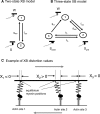Cardiac electromechanical models: from cell to organ
- PMID: 21886622
- PMCID: PMC3154390
- DOI: 10.3389/fphys.2011.00043
Cardiac electromechanical models: from cell to organ
Abstract
The heart is a multiphysics and multiscale system that has driven the development of the most sophisticated mathematical models at the frontiers of computational physiology and medicine. This review focuses on electromechanical (EM) models of the heart from the molecular level of myofilaments to anatomical models of the organ. Because of the coupling in terms of function and emergent behaviors at each level of biological hierarchy, separation of behaviors at a given scale is difficult. Here, a separation is drawn at the cell level so that the first half addresses subcellular/single-cell models and the second half addresses organ models. At the subcellular level, myofilament models represent actin-myosin interaction and Ca-based activation. The discussion of specific models emphasizes the roles of cooperative mechanisms and sarcomere length dependence of contraction force, considered to be the cellular basis of the Frank-Starling law. A model of electrophysiology and Ca handling can be coupled to a myofilament model to produce an EM cell model, and representative examples are summarized to provide an overview of the progression of the field. The second half of the review covers organ-level models that require solution of the electrical component as a reaction-diffusion system and the mechanical component, in which active tension generated by the myocytes produces deformation of the organ as described by the equations of continuum mechanics. As outlined in the review, different organ-level models have chosen to use different ionic and myofilament models depending on the specific application; this choice has been largely dictated by compromises between model complexity and computational tractability. The review also addresses application areas of EM models such as cardiac resynchronization therapy and the role of mechano-electric coupling in arrhythmias and defibrillation.
Keywords: actin; activation; active tension; electromechanical model; heart; myofilament; myosin; stretch-induced arrhythmias.
Figures






References
-
- Abraham W. T., Fisher W. G., Smith A. L., Delurgio D. B., Leon A. R., Loh E., Kocovic D. Z., Packer M., Clavell A. L., Hayes D. L., Ellestad M., Trupp R. J., Underwood J., Pickering F., Truex C., Mcatee P., Messenger J. (2002). Cardiac resynchronization in chronic heart failure. N. Engl. J. Med. 346, 1845–185310.1056/NEJMoa013168 - DOI - PubMed
Grants and funding
LinkOut - more resources
Full Text Sources
Research Materials

